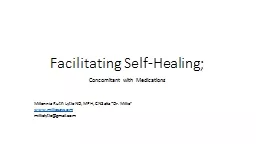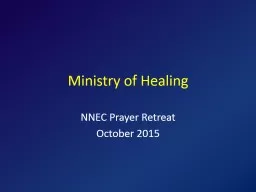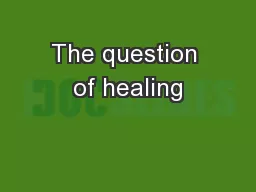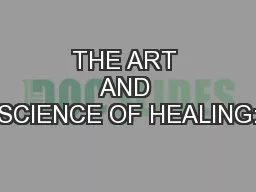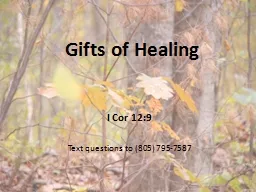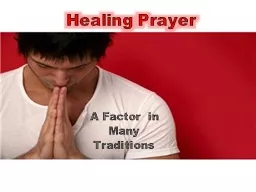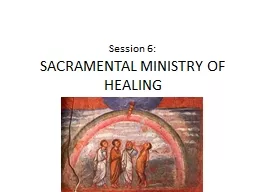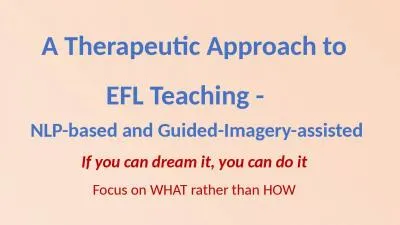PPT-Facilitating Self-Healing;
Author : lindy-dunigan | Published Date : 2016-06-03
Concomitant with Medications Millennia Ruth Lytle ND MPH CNS aka Dr Millie wwwmilliesaysom millielytlegmailcom Introduction To facilitate the bodys innate ability
Presentation Embed Code
Download Presentation
Download Presentation The PPT/PDF document "Facilitating Self-Healing;" is the property of its rightful owner. Permission is granted to download and print the materials on this website for personal, non-commercial use only, and to display it on your personal computer provided you do not modify the materials and that you retain all copyright notices contained in the materials. By downloading content from our website, you accept the terms of this agreement.
Facilitating Self-Healing;: Transcript
Concomitant with Medications Millennia Ruth Lytle ND MPH CNS aka Dr Millie wwwmilliesaysom millielytlegmailcom Introduction To facilitate the bodys innate ability to heal itself is a principle of NM. Facilitating ReflectionA Manual for Leaders and Educators Written and Compiled byJulie Reed & Christopher Koliba http://www.uvm.edu/~dewey/reflection_manual/index.html (1 of 3) [5/13/03 9:47:18 AM] F Seven Tips to Facilitating a Great Meeting Jessica Bell campaigns | facilitation | training jessicabell.org Seven Tips to Facilitating a Great Meeting | JessicaBell.org A facilitator’s 1. October-December 2011. Proportionate Review. Management Information. PRS Update (Feb/Mar 2012). PR currently available in England; Wales and Scotland:. England- 6 REC Centres . Wales- 1 REC . Scotland- 1REC. . L. earning . Teams. Learners will be able to…. Learning objectives. Understand the responsibilities and skills needed by facilitators and other roles that contribute to a team’s success.. Acquire skills and strategies for facilitating learning teams, such as forming agreements, using purpose and . NNEC Prayer Retreat. October 2015. Overview. Our world is a vast lazar house, a scene of misery that we dare not allow even our thoughts to dwell upon. Did we realize it as it is, the burden would be too terrible. Yet God feels it all. In order to destroy sin and its results He gave His best Beloved, and . 1. Can . God heal?. Yes, He can!. 2. Does . God heal?. OLD TESTAMENT. ACTS. GOSPELS. Yes, He does. 3. Does . God heal t. oday. ?. Yes, say the charismatics. God promised. Jesus commanded. The. . Holy Spirit gifts us. CARDWELL C. NUCKOLS, PhD. CNUCKOLS@ELITECORP1.COM. WWW.CNUCKOLS.COM. THE ART AND SCIENCE OF HEALING. THE LAW OF SENSITIVE DEPENDENCE ON INITIAL CONDITIONS. Nonlinear quantum dynamics. A small variation in a pattern of inputs can result in a very large change in eventual outputs. Presentation. A sample presentation to share with Success Team members . focused on working together to improve On-Track rates. . Facilitating Effective Adult Collaboration . & Conversation. A. How Adults Can Work Together . . 1. “When we lived close to the sacred pipe and sweat lodge, there many old women and men.”. ~Matthew Bear Shield . Oglala Lakota . Wakan. . Iyeska. (Interpreter of the Sacred. ). Sina. Text questions to (805) 795-7587. Theology. He will wipe every tear from their eyes. There will be no more death or mourning or crying or pain, for the old order of things have passed away. Rev 21:4. Healing Prayer A Factor in Many Traditions Healing prayers may be offered for oneself or for others who are in need of healing: physical, emotional, or spiritual healing. It can be an individual action or a group action. Sacramental Healing. Reading: James 5.13-16. Sacraments, Signs and Symbols. "an outward and physical sign of an inner and spiritual grace". Sacraments of Baptism (Acts 2.38) and Holy Communion (1 Cor 11.23ff) are both healing. Tatiana Pyatina and Toshifumi Sugama. Brookhaven National Laboratory . Work performed under DOE EERE Geothermal Technologies Program . Objectives and approach. Strength recovery. Fractures and cracks . - . . . NLP-based and Guided-Imagery-assisted. If you can dream it, you can do it. Focus on WHAT rather than HOW. In post-modern age . -. instant messaging, . multi-tasking , excessive stimuli ,incessant transformation .
Download Document
Here is the link to download the presentation.
"Facilitating Self-Healing;"The content belongs to its owner. You may download and print it for personal use, without modification, and keep all copyright notices. By downloading, you agree to these terms.
Related Documents

